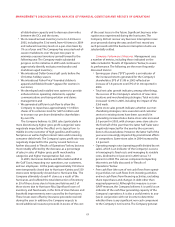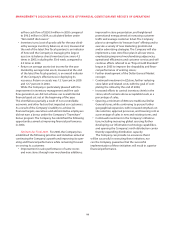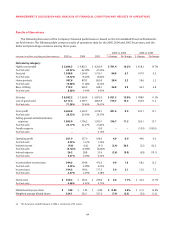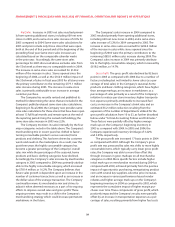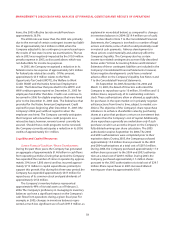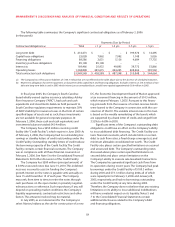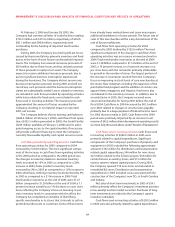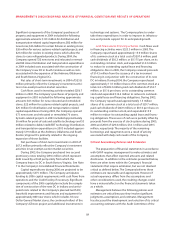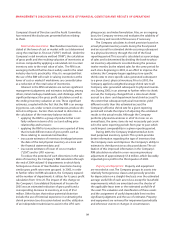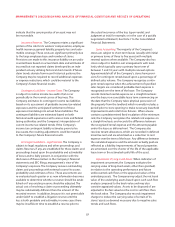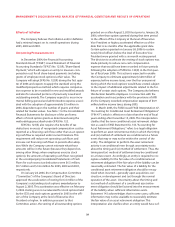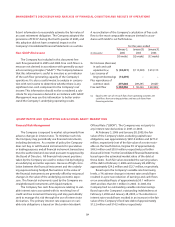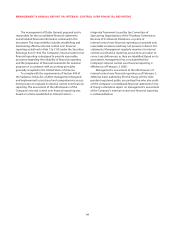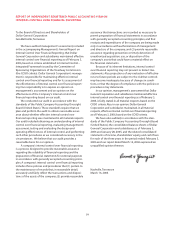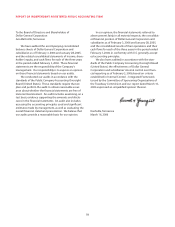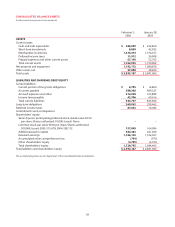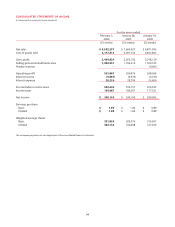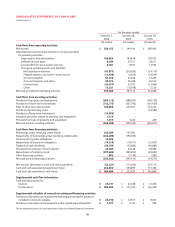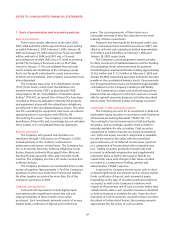Dollar General 2005 Annual Report Download - page 31
Download and view the complete annual report
Please find page 31 of the 2005 Dollar General annual report below. You can navigate through the pages in the report by either clicking on the pages listed below, or by using the keyword search tool below to find specific information within the annual report.
27
MANAGEMENT’S DISCUSSION AND ANALYSIS OF FINANCIAL CONDITION AND RESULTS OF OPERATIONS
indicate that the carrying value of an asset may not
be recoverable.
Insurance Reserves. The Company retains a significant
portion of the risk for its workers’ compensation, employee
health insurance, general liability, property loss and auto-
mobile coverage.These costs are significant primarily due
to the large employee base and number of stores.
Provisions are made to this insurance liability on an undis-
counted basis based on actual claim data and estimates of
incurred but not reported claims developed by an inde-
pendent actuary utilizing historical claim trends. If future
claim trends deviate from recent historical patterns, the
Company may be required to record additional expenses
or expense reductions, which could be material to the
Company’s future financial results.
Contingent Liabilities – Income Taxes.The Company
is subject to routine income tax audits that occur
periodically in the normal course of business.The
Company estimates its contingent income tax liabilities
based on its assessment of probable income tax-related
exposures and the anticipated settlement of those
exposures translating into actual future liabilities.The
contingent liabilities are estimated based on both
historical audit experiences with various state and federal
taxing authorities and the Company’s interpretation of
current income tax-related trends. If the Company’s
income tax contingent liability estimates prove to be
inaccurate, the resulting adjustments could be material
to the Company’s future financial results.
Contingent Liabilities - Legal Matters. The Company is
subject to legal, regulatory and other proceedings and
claims. Reserves, if any, are established for these claims and
proceedings based upon the probability and estimability
of losses and to fairly present, in conjunction with the
disclosures of these matters in the Company’s financial
statements and SEC filings, management’s view of the
Company’s exposure. The Company reviews outstanding
claims and proceedings with external counsel to assess
probability and estimates of loss. These assessments are
re-evaluated each quarter or as new information becomes
available to determine whether a reserve should be estab-
lished or if any existing reserve should be adjusted. The
actual cost of resolving a claim or proceeding ultimately
may be substantially different than the amount of the
recorded reserve. In addition, because it is not permissible
under GAAP to establish a litigation reserve until the
loss is both probable and estimable, in some cases there
may be insufficient time to establish a reserve prior to
the actual incurrence of the loss (upon verdict and
judgment at trial, for example, or in the case of a quickly
negotiated settlement). See Note 7 to the Consolidated
Financial Statements.
Lease Accounting. The majority of the Company’s
stores are subject to short-term leases (usually with initial
or primary terms of three to five years) with multiple
renewal options when available. The Company also has
stores subject to build-to-suit arrangements with land-
lords, which typically carry a primary lease term of
between 7 and 10 years with multiple renewal options.
Approximately half of the Company’s stores have provi-
sions for contingent rentals based upon a percentage of
defined sales volume. The Company recognizes contin-
gent rental expense when the achievement of specified
sales targets are considered probable. Rent expense is
recognized over the term of the lease. The Company
records minimum rental expense on a straight-line basis
over the base, non-cancelable lease term commencing on
the date that the Company takes physical possession of
the property from the landlord, which normally includes a
period prior to store opening to make necessary leasehold
improvements and install store fixtures. When a lease
contains a predetermined fixed escalation of the minimum
rent, the Company recognizes the related rent expense on
a straight-line basis and records the difference between
the recognized rental expense and the amounts payable
under the lease as deferred rent. The Company also
receives tenant allowances, which are recorded in deferred
incentive rent and are amortized as a reduction to rent
expense over the term of the lease. Any difference between
the calculated expense and the amounts actually paid are
reflected as a liability. Improvements of leased properties
are amortized over the shorter of the life of the applicable
lease term or the estimated useful life of the asset.
Impairment of Long-Lived Assets. When indicators of
impairment are present, the Company evaluates the
carrying value of long-lived assets, other than goodwill,
in relation to the operating performance and future
undiscounted cash flows or the appraised values of the
underlying assets. The Company may adjust the net book
value of the underlying assets based upon such cash flow
analysis compared to the book value and may also
consider appraised values. Assets to be disposed of are
adjusted to the fair value less the cost to sell if less than
the book value. The Company also records impairment
charges to reduce the carrying value of certain of its
stores’ assets as deemed necessary due to negative sales
trends and cash flows.


